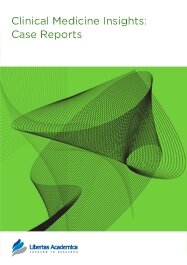

Publication Date: 05 Jul 2012
Type: Case report
Journal: Clinical Medicine Insights: Case Reports
Citation: Clinical Medicine Insights: Case Reports 2012:5 99-106
doi: 10.4137/CCRep.S9861

Introduction: Typical spike-and-wave activity (TSWA) in the electroencephalogram (EEG) indicates idiopathic generalized epilepsy (IGE). IGE-related nonconvulsive status epilepticus (NCSE) is typically an absence status epilepticus (ASE). ASE and TSWA respond dramatically to benzodiazepines. Patients with no history of seizure/epilepsy may develop ASE “de novo” in the context of an acute brain disorder. However, we are aware of only one previous case of de novo ASE with TSWA in hypoxic-ischemic brain injury.
Case presentation: A 65-year-old man, with congestive heart failure and history of substance abuse, survived cardiorespiratory arrest after 18 minutes of cardiopulmonary resuscitation. Post-resuscitation, the patient was in coma with intact brainstem function. Toxicology was positive for cocaine and marijuana. Eyelid myoclonus suggested NCSE, which was initially treated with lorazepam and fosphenytoin. EEG monitoring showed sustained TSWA confirming NCSE and demonstrating de novo ASE (the patient and his family never had seizure/epilepsy). The TSWA was resistant to lorazepam, levetiracetam, and low-dose midazolam; it was eliminated only with midazolam at a dose that resulted in burst-suppression (≥1.2 mg/kg/hour).
Conclusion: This is an unusual case of TSWA and hypoxic-ischemic brain injury in a patient with no history of seizure/epilepsy. The TSWA was relatively resistant to benzodiazepines suggesting that cerebral hypoxia-ischemia spared the thalamocortical apparatus generating TSWA but impaired the cortical/thalamic inhibitory circuits where benzodiazepines act to suppress TSWA. Albeit rare, ‘post-hypoxic’ TSWA offers us some valuable insights for classifying and managing nonconvulsive status epilepticus.
PDF (4.25 MB PDF FORMAT)
RIS citation (ENDNOTE, REFERENCE MANAGER, PROCITE, REFWORKS)
BibTex citation (BIBDESK, LATEX)
XML
PMC HTML

This is the first time I have published published an article in Clinical Medicine Insights Case Report. I was pleased to find that the publishing staff were helpful in guiding my submission and I was impressed by the prompt processing and speed of publication.

All authors are surveyed after their articles are published. Authors are asked to rate their experience in a variety of areas, and their responses help us to monitor our performance. Presented here are their responses in some key areas. No 'poor' or 'very poor' responses were received; these are represented in the 'other' category.See Our Results
Copyright © 2013 Libertas Academica Ltd (except open access articles and accompanying metadata and supplementary files.)
Facebook Google+ Twitter
Pinterest Tumblr YouTube